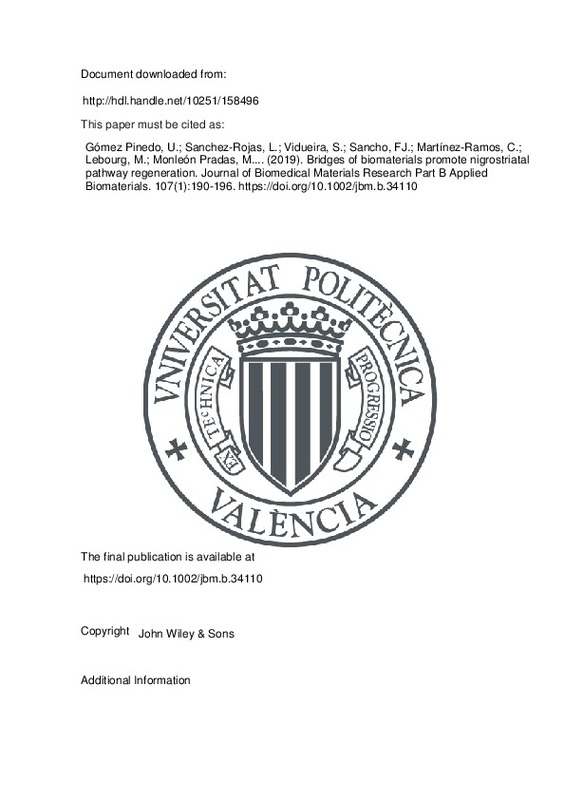Pekny, M., Wilhelmsson, U., & Pekna, M. (2014). The dual role of astrocyte activation and reactive gliosis. Neuroscience Letters, 565, 30-38. doi:10.1016/j.neulet.2013.12.071
Bliss, T. M., Andres, R. H., & Steinberg, G. K. (2010). Optimizing the success of cell transplantation therapy for stroke. Neurobiology of Disease, 37(2), 275-283. doi:10.1016/j.nbd.2009.10.003
Tam, R. Y., Fuehrmann, T., Mitrousis, N., & Shoichet, M. S. (2013). Regenerative Therapies for Central Nervous System Diseases: a Biomaterials Approach. Neuropsychopharmacology, 39(1), 169-188. doi:10.1038/npp.2013.237
[+]
Pekny, M., Wilhelmsson, U., & Pekna, M. (2014). The dual role of astrocyte activation and reactive gliosis. Neuroscience Letters, 565, 30-38. doi:10.1016/j.neulet.2013.12.071
Bliss, T. M., Andres, R. H., & Steinberg, G. K. (2010). Optimizing the success of cell transplantation therapy for stroke. Neurobiology of Disease, 37(2), 275-283. doi:10.1016/j.nbd.2009.10.003
Tam, R. Y., Fuehrmann, T., Mitrousis, N., & Shoichet, M. S. (2013). Regenerative Therapies for Central Nervous System Diseases: a Biomaterials Approach. Neuropsychopharmacology, 39(1), 169-188. doi:10.1038/npp.2013.237
Skop, N. B., Calderon, F., Cho, C. H., Gandhi, C. D., & Levison, S. W. (2014). Improvements in biomaterial matrices for neural precursor cell transplantation. Molecular and Cellular Therapies, 2(1), 19. doi:10.1186/2052-8426-2-19
Yasuhara, T., Kameda, M., Sasaki, T., Tajiri, N., & Date, I. (2017). Cell Therapy for Parkinson’s Disease. Cell Transplantation, 26(9), 1551-1559. doi:10.1177/0963689717735411
Orive, G., Anitua, E., Pedraz, J. L., & Emerich, D. F. (2009). Biomaterials for promoting brain protection, repair and regeneration. Nature Reviews Neuroscience, 10(9), 682-692. doi:10.1038/nrn2685
Walker, P. A., Aroom, K. R., Jimenez, F., Shah, S. K., Harting, M. T., Gill, B. S., & Cox, C. S. (2009). Advances in Progenitor Cell Therapy Using Scaffolding Constructs for Central Nervous System Injury. Stem Cell Reviews and Reports, 5(3), 283-300. doi:10.1007/s12015-009-9081-1
Zhong, Y., & Bellamkonda, R. V. (2008). Biomaterials for the central nervous system. Journal of The Royal Society Interface, 5(26), 957-975. doi:10.1098/rsif.2008.0071
Pérez‐GarnezM BarciaJA Gómez‐PinedoU Monleón‐PradasM Vallés‐LluchA.Materials for Central Nervous System Tissue Engineering Cells and Biomaterials in Regenerative Medicine. InTech;2014. Chap 7.
Sinha, V. R., Bansal, K., Kaushik, R., Kumria, R., & Trehan, A. (2004). Poly-ϵ-caprolactone microspheres and nanospheres: an overview. International Journal of Pharmaceutics, 278(1), 1-23. doi:10.1016/j.ijpharm.2004.01.044
Raisman, G. (2001). Olfactory ensheathing cells — another miracle cure for spinal cord injury? Nature Reviews Neuroscience, 2(5), 369-375. doi:10.1038/35072576
Raisman, G., & Li, Y. (2007). Repair of neural pathways by olfactory ensheathing cells. Nature Reviews Neuroscience, 8(4), 312-319. doi:10.1038/nrn2099
Fairless, R., & Barnett, S. C. (2005). Olfactory ensheathing cells: their role in central nervous system repair. The International Journal of Biochemistry & Cell Biology, 37(4), 693-699. doi:10.1016/j.biocel.2004.10.010
Collins, A., Li, D., Mcmahon, S. B., Raisman, G., & Li, Y. (2017). Transplantation of Cultured Olfactory Bulb Cells Prevents Abnormal Sensory Responses during Recovery from Dorsal Root Avulsion in the Rat. Cell Transplantation, 26(5), 913-924. doi:10.3727/096368917x695353
Navarro, X., Valero, A., Gudiño, G., Forés, J., Rodríguez, F. J., Verdú, E., … Nieto-Sampedro, M. (1999). Ensheathing glia transplants promote dorsal root regeneration and spinal reflex restitution after multiple lumbar rhizotomy. Annals of Neurology, 45(2), 207-215. doi:10.1002/1531-8249(199902)45:2<207::aid-ana11>3.0.co;2-k
Gómez-Pinedo, U., Félez, M. C., Sancho-Bielsa, F. J., Vidueira, S., Cabanes, C., Soriano, M., … Barcia, J. A. (2008). Improved technique for stereotactic placement of nerve grafts between two locations inside the rat brain. Journal of Neuroscience Methods, 174(2), 194-201. doi:10.1016/j.jneumeth.2008.07.008
HowardCV ReedMG.Unbiased Stereology: Three‐Dimensional Measurement in Microscopy. Oxford: Bioimaging Group;1998.
Collier, T. J., & Springer, J. E. (1991). Co-grafts of embryonic dopamine neurons and adult sciatic nerve into the denervated striatum enhance behavioral and morphological recovery in rats. Experimental Neurology, 114(3), 343-350. doi:10.1016/0014-4886(91)90160-e
Bourke, J. L., Coleman, H. A., Pham, V., Forsythe, J. S., & Parkington, H. C. (2014). Neuronal Electrophysiological Function and Control of Neurite Outgrowth on Electrospun Polymer Nanofibers Are Cell Type Dependent. Tissue Engineering Part A, 20(5-6), 1089-1095. doi:10.1089/ten.tea.2013.0295
Nga, V. D. W., Lim, J., Choy, D. K. S., Nyein, M. A., Lu, J., Chou, N., … Teoh, S.-H. (2015). Effects of Polycaprolactone-Based Scaffolds on the Blood–Brain Barrier and Cerebral Inflammation. Tissue Engineering Part A, 21(3-4), 647-653. doi:10.1089/ten.tea.2013.0779
Pérez-Garnés, M., Martínez-Ramos, C., Barcia, J. A., Escobar Ivirico, J. L., Gómez-Pinedo, U., Vallés-Lluch, A., & Monleón Pradas, M. (2012). One-Dimensional Migration of Olfactory Ensheathing Cells on Synthetic Materials: Experimental and Numerical Characterization. Cell Biochemistry and Biophysics, 65(1), 21-36. doi:10.1007/s12013-012-9399-1
Diban, N., Ramos-Vivas, J., Remuzgo-Martinez, S., Ortiz, I., & Urtiaga, A. (2015). Poly(ε-caprolactone) Films with Favourable Properties for Neural Cell Growth. Current Topics in Medicinal Chemistry, 14(23), 2743-2749. doi:10.2174/1568026614666141215153932
[-]







![[Cerrado]](/themes/UPV/images/candado.png)


